Organize research materials digitally and collaboratively
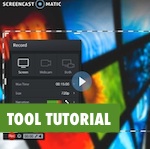 Tiffany Michael, from Crossett Brook Middle School in Waterbury, Vermont, describes how her use of Padlet evolved to eventually revolutionize the way that she teaches students to conduct research.
Tiffany Michael, from Crossett Brook Middle School in Waterbury, Vermont, describes how her use of Padlet evolved to eventually revolutionize the way that she teaches students to conduct research.
I love her story because it has something for everybody. In addition to practical and actionable advice for teachers who want to try to use Padlet, Michael also describes her journey in a way that is informative for coaches, tech integrationists, and administrators.
What is Padlet?
For those of you new to this tool, Padlet is a virtual bulletin board, where you and your students can pin notes, photos, audio and video reflections, and it really does look like a classroom bulletin board. Check out this padlet by a Vermont kindergarten class, asking for guests to drop by and contribute their own answers about why people learn to code:
Created with Padlet
How Mrs. Michael revolutionized student research with Padlet
Mrs. Michael’s journey exemplifies the way that a relatively simple tech tool can help a teacher make her classroom more student-centered. After Michael was introduced to Padlet during a facilitated data analysis session, she kept it in the back of her mind as a tool she knew she wanted to use in the future.
At a later date she saw a way to use the tool and jumped in with both feet, a risk-taking approach that is part of her classroom culture. Her use of the tool has evolved and expanded over time, with students providing suggestions, feedback, and lending their voices to her presentation as she shares what she has learned.
And this cycle from initial exposure to professional sharing happened in just a few months.
You can read or watch Mrs Michael’s full story, below. This material was originally presented at the 2016 Dynamic Landscapes conference, here in Vermont.
Revolutionizing student research with Padlet

Tiffany Michael: I’m here today because I stumbled upon Padlet this school year and it was amazing. I think I was bragging about Padlet so much with my colleagues — “Oh, look at this, it’s so awesome and amazing!” — and as educators we get all sorts of shiny gadgets and things thrown at us, and some of them are not user-friendly, and some things are not intuitive and some things have all kinds of ads with the free account. It can be really frustrating, but this was one of those tools where I just latched on and found it really easy and versatile.
What is Padlet? Let my students explain.
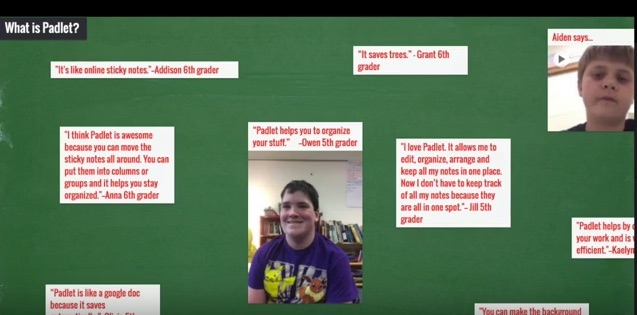
Tiffany Michael: This is a Padlet actually, that we made, to explain Padlet.
“Padlet helps by organizing your work and is very efficient.” –Kaelyn, 6th grader
“You can make the background fit what you are doing.” –Britta, 6th grader
Tiffany Michael: And by background, Britta means there’s lots of wallpaper you can choose, and you know kids always like to jazz things up. The other cool thing about Padlet is that you can link media in, so we have not just the words that the kids typed in, but Owen wanted to have his picture included with his quote, and Aiden preferred to do a video.
Padlet was a very helpful tool. It allowed me to do a lot of hard projects with it and not have any of my work get lost. Padlet allows you to have different links to different things. If you ever decide to use Padlet in the future, it’s not that complicated to do. –Aiden
I love Padlet, it allows me to edit, organize and arrange, and keep all of my notes in one place. Now I don’t have to keep track of all my notes because they are all in one spot. –Jill, 5th grader
It saves trees. –Grant, 6th grader
Nic M: The reason he’s saying that is because normally we would just use these little notecards that we’d write our thinking down on, and we’d end up wasting a lot of paper.
Padlet helps you organize your stuff. –Owen, 5th grader
It’s like online sticky notes. –Addison, 6th grader
I think Padlet is awesome, because you can move the sticky notes all around. You can put them into columns or groups and it helps you stay organized. –Anna, 6th grader
Padlet is like a Google Doc, because it saves automatically. –Olivia, 5th grader
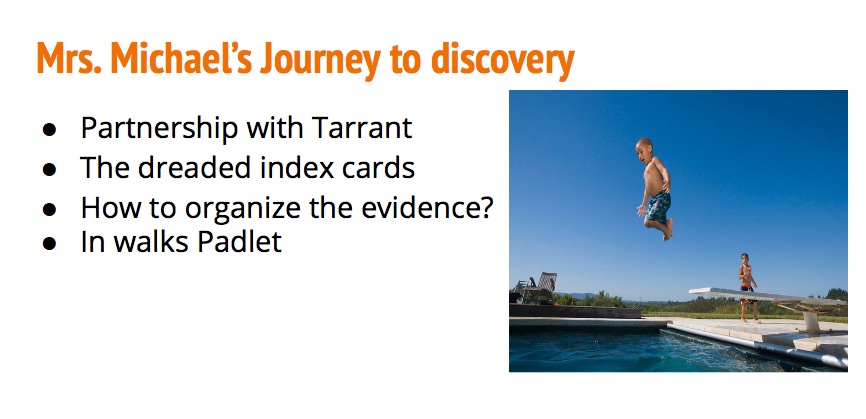
Michael: I teach 5th and 6th grade, so I have a multi-age Language Arts/Science class. We made a Padlet so they could show you some of the things Padlet could do. I chose the above image because when I’m presented with something new, I just like to jump off the deep end and say, “We’re just gonna try this, kids.”
We went 1:1 this year, we got our Chromebooks late in the year, and I was ecstatic, because at the time all we had were these older netbooks, which were very very slow and challenging. But with all the tech that comes down the line, I say to the kids:
Nic M: “We’re gonna try this, and it might backfire on us.”
Michael: I usually say “This might blow up in our faces, but we’re going to learn together and I think what I love about the kids is that they’re not afraid to click. Whereas us adults, sometimes we’re afraid we’re going to mess it up or break it, or we might lose something. But the kids figure stuff out so fast. So, the culture of my classroom is: “Oh, I figured out how to do this!” Great: show us now. But Padlet’s easy. It’s kind of a no-brainer.
Anyway, here’s how I learned about Padlet:
My class started our annual unit on argument writing, so we were doing rigorous, research-based argument writing. I pulled out… the index cards. And the index cards wound up like confetti, of course, all the way around the classroom and down the hallway. But that was how I did it: they’re going to have all their index cards to collect their research on, etc etc. I gave the kids the article we were going to argue, about whether homework is good or bad for you.
So they were in groups, they read the article, they had their index cards, they wrote down some evidence they found, and then I went home and I was kind of beating my head against the wall: I have three classes and I teach them all the same thing. That’s more than 60 kids.
What I wanted them to get out of this was that now you have all this research, you have to sort it, and find like ideas, that lead to what reasons we’re going to argue.
I was thinking, “Maybe I’ll get big strips of bulletin board paper, one for each class, and, I was just having management nightmares, to do it for three classes. This is the first time I’d taught it with three classes, and it was turning out to be way less manageable than with just one class.
All of a sudden I get this epiphany, late at night: Padlet! I can try to use Padlet now.
I originally made one Padlet for all three classes, but I quickly realized it was going to get jammed up with so many notes and students, so I quickly duplicated it between classes, pushed out the link and was all set.
The kids were in groups, and I said: “Okay, I want you to take all the evidence you have and pick the three best pieces, the ones you feel that you have. Pick one person from your group, to type, and have them put their initials, so we can keep track.” They had Padlet in front of them on their screens, I had it on a big projection screen. This was a group Padlet. I created it, I’m the owner, I pushed them the link, and they could all post on it collaboratively.
When we did this, they were still on netbooks. I created a free Padlet account, and pushed them the link, and they could just start working. They didn’t need to log in or create an account, so at this point they didn’t have to have their own accounts.
That was Day 1, and afterwards I was in meetings with my team and all I can talk about is how great this Padlet experience was.
And then I go home, and I have another epiphany:
They could all have their own accounts, with their own Padlets for their own research.
I’ve just solved the tremendous problem of the confetti of index cards: it’s all stored in one digital home, and it saves automatically.
The next day, I had each kid create a Google Doc. So imagine Google Docs and Padlets having a kind of symbiotic relationship: they always had the two tabs open because they were going back and forth between the two. I had them put their Padlet link into a Google Doc and share it with me so I could access their Padlet at any point.
I asked them to store the links where they originally found their evidence in the Google Doc, so I could make sure they were using reputable sources. I was looking to see how much evidence they’d collected, had they gotten to the point where they’d organized the evidence, I wanted to see that they had statistics and quotes that were actually relevant, or did they just write “Homework is bad”, with a link, and not pull anything specific.
It really helped when I was conferencing with kids. If I asked them where they found their facts, they couldn’t just answer, “Google”.
I don’t know how I would’ve managed more than 60 kids’ index cards. I don’t know how I would have stayed on top of that.
The next step in the process was to organize the evidence into similar ideas.
The nice thing about Padlet is that they can manipulate the pieces and move them around on the screen.
A little bit of backwards-design thinking: What evidence do I have, and what is my evidence saying?
In having taught opinion and persuasive argument writing in the past, I felt like with this round, the argument writing was phenomenal. They had so many statistics and facts to back up their arguments.
Then we turned this into what I like to call “the living graphic organizer”:
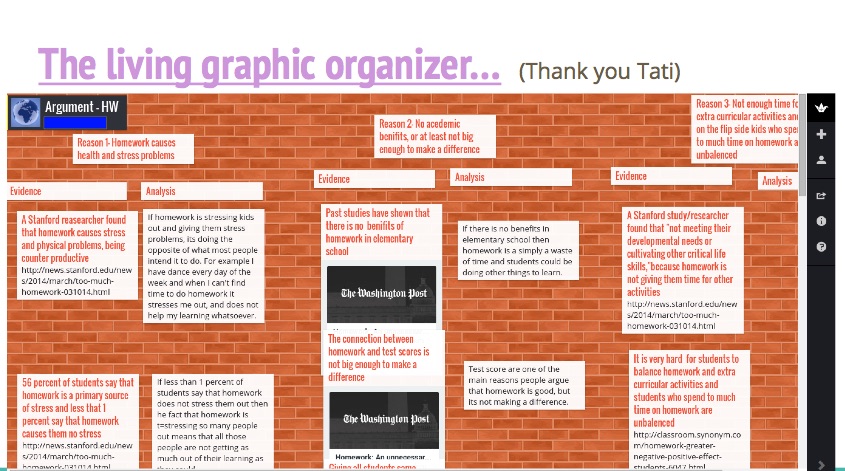
My use of Padlet was constantly evolving. After they organized their data, they made labels for the organized sections of data right in Padlet. And some of the kids even got to the point where they included their own analysis, labeled as such, before they ever began writing. It became this amazing graphic organizer.
The other really nice thing is that Padlet gives you as much space as you need. So if you kept adding notes, Padlet would keep expanding your workspace to accommodate all that material.
It was also really useful when conferencing with students to see where they didn’t have support yet, for part of their arguments. I felt like I was way more effective with this round of argument writing.
But more about the student perspective on Padlet
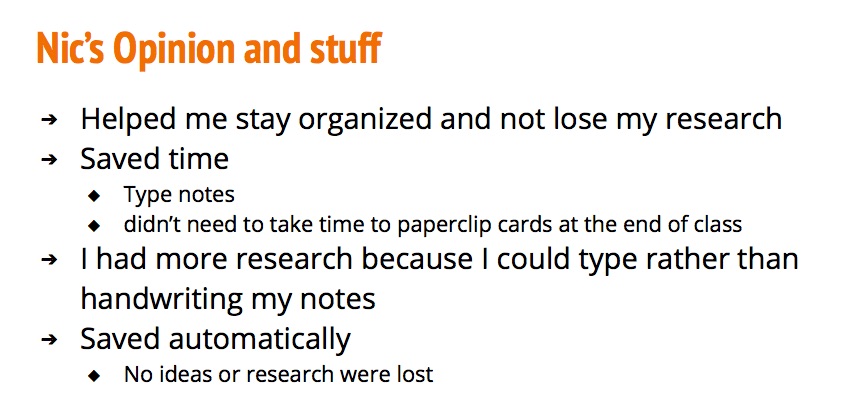
Nic M: So what I thought about, about Padlet, was: I have really bad organizational problems. Like, really bad. And so Padlet really helped me stay organized and not lose my research. It also saved time, because I could type notes, and that was a lot easier for me than writing with a pencil, because I’m not as fast at that. I didn’t need to take time to paperclip cards at the end of class, which you kind of have to do, and then you put them in your binder and probably lose them. I had more research because I could type my notes. It saved automatically, so no ideas or research was lost.
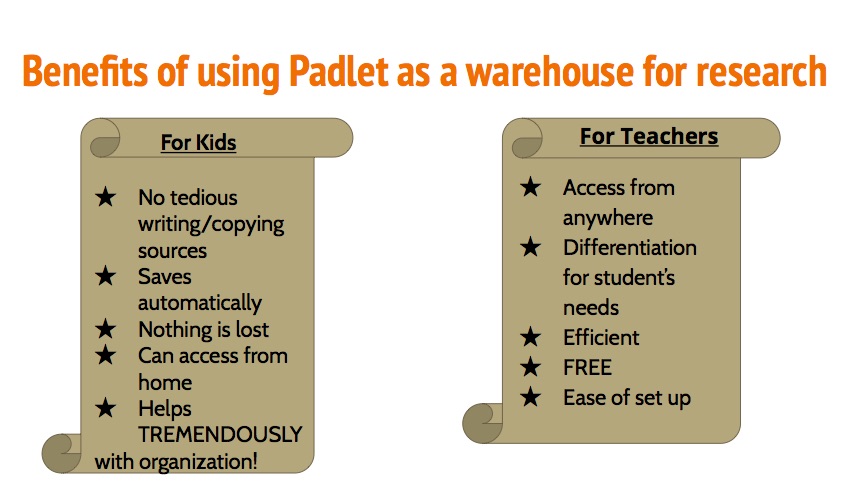
Tiffany Michael: Why do you think teachers like Padlet?
Nic M: Because — *puts on fake teacher voice* — “We can access it from anywhere! Differentiation for student’s needs!”
Tiffany Michael: Do I really talk like that?
Nic M: Not really.
Tiffany Michael: Anyway, it helped tremendously with organization. The organized kids loved it, because they appreciate organization. The kids who lack organizational skills loved it, because they could recognize that it actually helped them. Ironically, when I solicited kids for testimonials, the first few kids that volunteered were kids who have organizational challenges. They saw the value in using the tool — they knew it helped them.
What else can you do with Padlet?
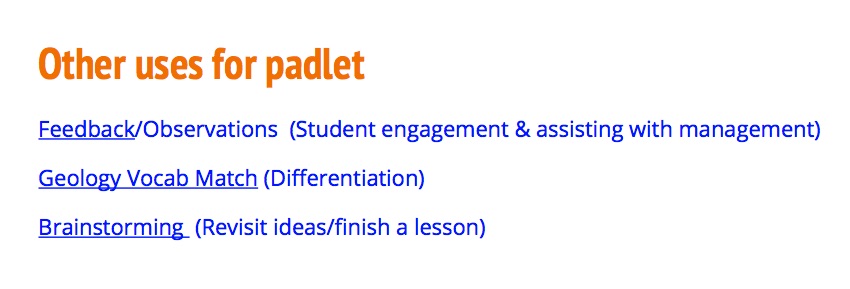
Other things we’ve used Padlet for? When you’re analyzing just about anything, the kids can take notes.
I have a blog where the kids write book reviews, so I wrote a mentor post for them, and said okay, I want you to brainstorm with a partner what that post had, do a little analysis before they started writing. I pushed them a link to a Padlet, had it up on the screen, and I could see whether notes were growing or note.
If a note stayed static, I knew I should go check in with that group. So it actually helped me manage my classroom.
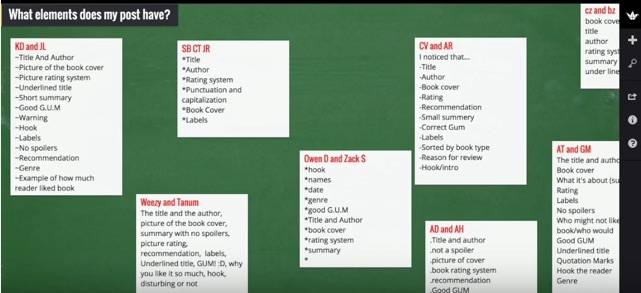
And it wasn’t on chart paper in the classroom, so when I got home, later that night I could still access it.
Another thing I did was that I have a student with Down Syndrome, and when I met with the special educator, I was teaching a geology unit, and we decided to do a matching activity with Padlet, between vocabulary and pictures, because that’s a really powerful activity for that particular student’s learning. We did a pre-assessment with this, and screenshot it, and we’ll do a post-assessment again at the end to measure growth.
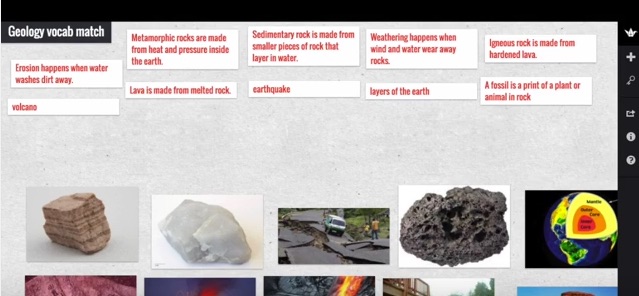
And then of course, one of the easiest things to use Padlet for is just brainstorming.
We did an ecology unit and brainstormed abiotic and biotic factors, and from there we put up the definition, then went and sorted the resources and organized them:
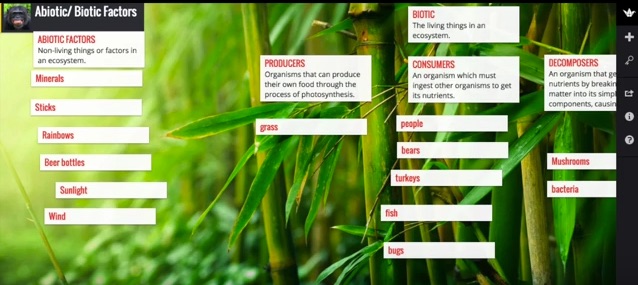
Here’s one more student perspective on using Padlet:

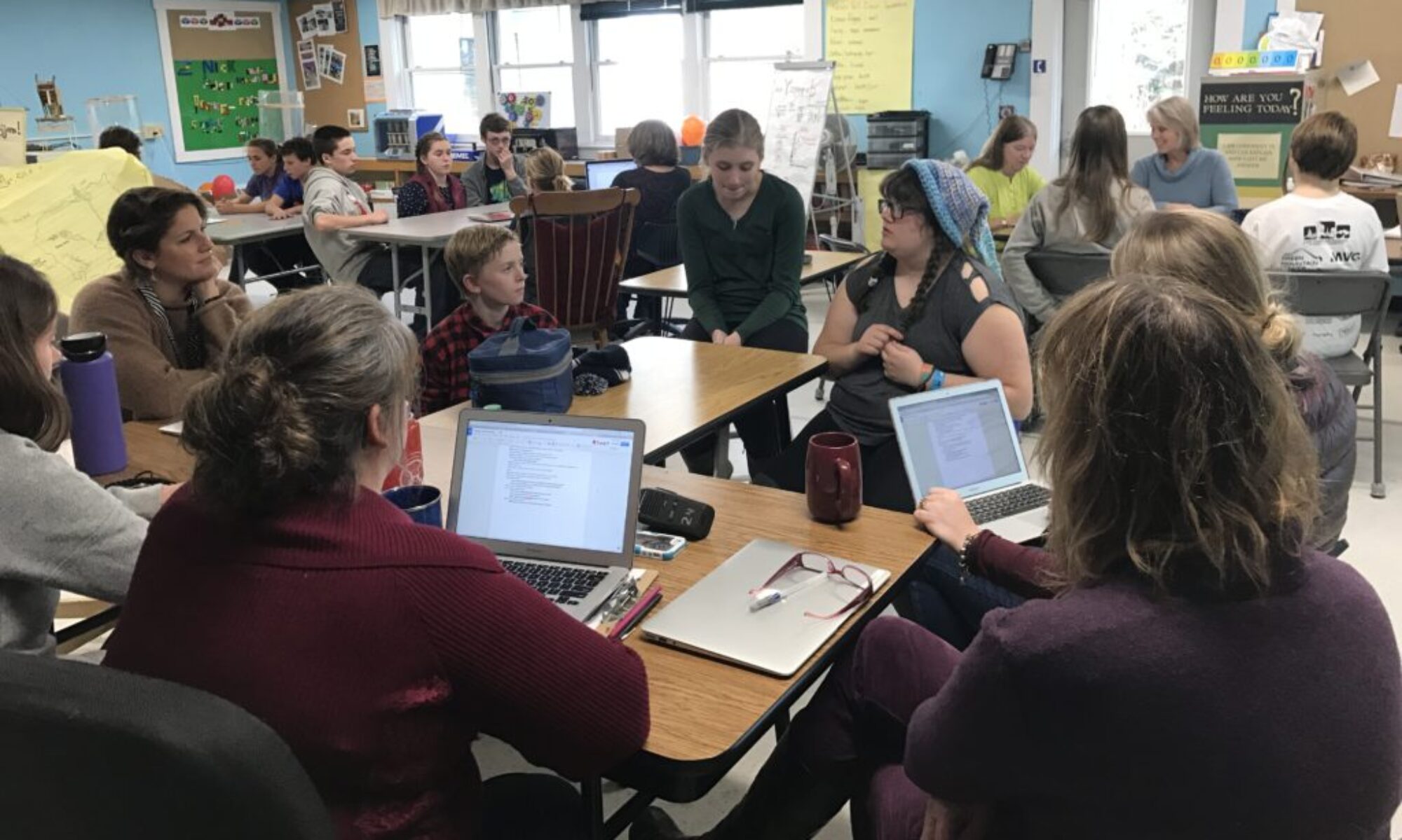

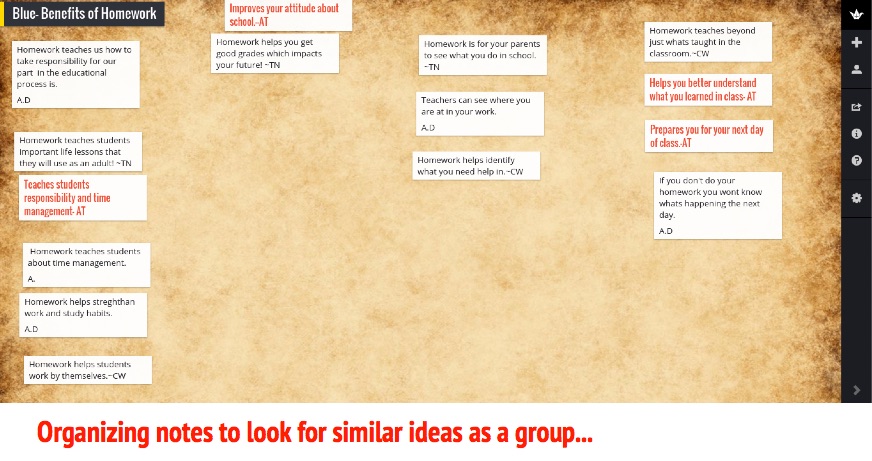
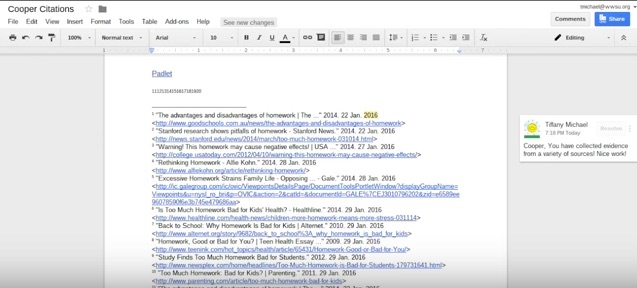
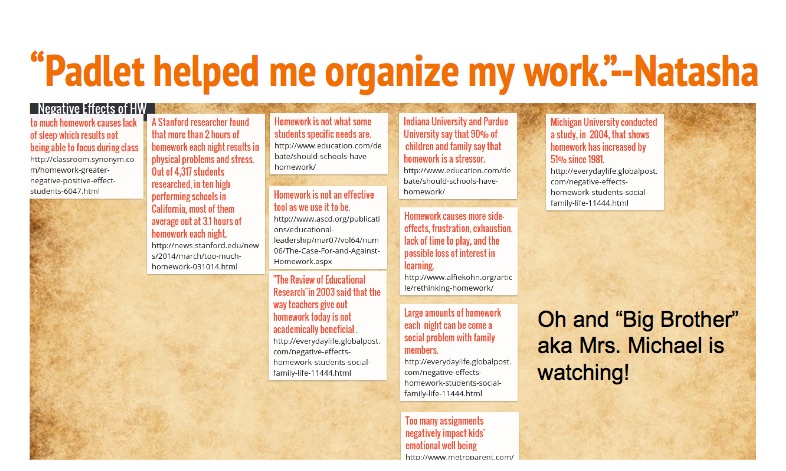
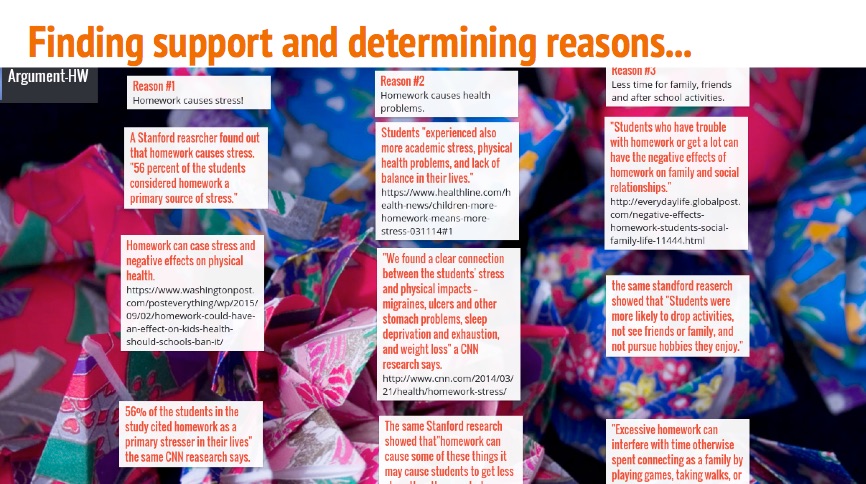
I think that Padlet is a great idea for any student to utilize. It gives them a different way to store information as well as Collab with classmates and their teachers. I also like that students can use this now to do research and projects.
I think pallet is a friendly used tool for students to navigate their work. Students can post pictures and make comments at the same time for teachers and other students to view.
As a Paraeducator, i believe Padlets help student to do research on projects and keep them up to date with important information
I think they would love doing work on padlet. We used it during our online only learning last year a lot…but not in as many ways I see on here, and I never had them create their own page- just add to what I had created